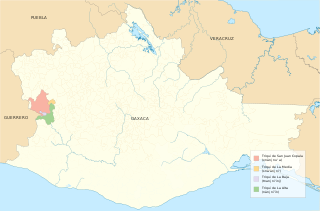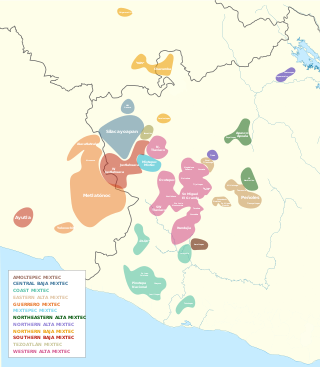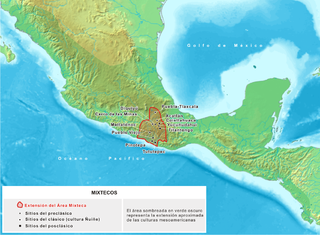Related Research Articles

The Mixtecs, or Mixtecos, are Indigenous Mesoamerican peoples of Mexico inhabiting the region known as La Mixteca of Oaxaca and Puebla as well as La Montaña Region and Costa Chica Regions of the state of Guerrero. The Mixtec culture was the main Mixtec civilization, which lasted from around 1500 BCE until being conquered by the Spanish in 1523.

The Oto-Manguean or Otomanguean languages are a large family comprising several subfamilies of indigenous languages of the Americas. All of the Oto-Manguean languages that are now spoken are indigenous to Mexico, but the Manguean branch of the family, which is now extinct, was spoken as far south as Nicaragua and Costa Rica. Oto-Manguean is widely viewed as a proven language family.

Eight Deer Jaguar Claw, or Eight Deer for brevity, was a powerful Mixtec ruler in 11th-century Oaxaca referred to in the 15th-century deerskin manuscript Codex Zouche-Nuttall, and other Mixtec manuscripts. His surname is alternatively translated Tiger-Claw and Ocelot-Claw. John Pohl has dated his life spanning from 1063 until his assassination in 1115.
In linguistics, upstep is a phonemic or phonetic upward shift of tone between the syllables or words of a tonal language. It is best known in the tonal languages of Sub-Saharan Africa. Upstep is a much rarer phenomenon than its counterpart, downstep.

The Mixtec languages belong to the Mixtecan group of the Oto-Manguean language family. Mixtec is spoken in Mexico and is closely related to Trique and Cuicatec. The varieties of Mixtec are spoken by over half a million people. Identifying how many Mixtec languages there are in this complex dialect continuum poses challenges at the level of linguistic theory. Depending on the criteria for distinguishing dialects from languages, there may be as few as a dozen or as many as fifty-three Mixtec languages.
Mesoamerica, along with Mesopotamia and China, is one of three known places in the world where writing is thought to have developed independently. Mesoamerican scripts deciphered to date are a combination of logographic and syllabic systems. They are often called hieroglyphs due to the iconic shapes of many of the glyphs, a pattern superficially similar to Egyptian hieroglyphs. Fifteen distinct writing systems have been identified in pre-Columbian Mesoamerica, many from a single inscription. The limits of archaeological dating methods make it difficult to establish which was the earliest and hence the progenitor from which the others developed. The best documented and deciphered Mesoamerican writing system, and the most widely known, is the classic Maya script. Earlier scripts with poorer and varying levels of decipherment include the Olmec hieroglyphs, the Zapotec script, and the Isthmian script, all of which date back to the 1st millennium BC. An extensive Mesoamerican literature has been conserved, partly in indigenous scripts and partly in postconquest transcriptions in the Latin script.

The Triqui, or Trique, languages are a family of Oto-Manguean spoken by 30,000 Trique people of the Mexican states of Oaxaca and the state of Baja California in 2007. They are also spoken by 5,000 immigrants to the United States. Triqui languages belong to the Mixtecan branch together with the Mixtec languages and Cuicatec.
Yahui is a supernatural figure that takes on various mixtures of animal and human forms within the culture and belief systems of the Mixtec—indigenous Mixtecan-speaking people of La Mixteca in central-southeastern Mexico. It is an important and recurring motif in Mixtec iconography, thought and culture, especially during the pre-Columbian era. As a supernatural figure, the yahui appears in Postclassic Mixtec codices as an entity wearing a serpent or reptilian tail and headdress and the carapace of a turtle.

Huamelulpan is an archaeological site of the Mixtec culture, located in the town of San Martín Huamelulpan at an elevation of 2,218 metres (7,277 ft), about 96 kilometres (60 mi) north-west of the city of Oaxaca, the capital of Oaxaca state.

The Mixtecan languages constitute a branch of the Oto-Manguean language family of Mexico. They include the Trique languages, spoken by about 24,500 people; Cuicatec, spoken by about 15,000 people; and the large expanse of Mixtec languages, spoken by about 511,000 people. The relationship between Trique, Cuicatec, and Mixtec, is an open question. Unpublished research by Terrence Kaufman in the 1980s supported grouping Cuicatec and Mixtec together.

The internal classification of Mixtec is controversial. Many varieties are mutually unintelligible and by that criterion separate languages. In the 16th century, Spanish authorities recognized half a dozen lenguas comprising the Mixtec lengua. It is not clear to what extent these were distinct languages at the time. Regardless, the colonial disintegration of the Mixtec nation and resulting isolation of local communities led to the rapid diversification of local dialects into distinct languages. Below are some attempts at Mixtec classification by various scholars.

Kagate or Syuba is a language from the subgroup of Tibetic languages spoken by the Kagate people primarily in the Ramechhap district of Nepal.
Chigmecatitlán Mixtec is a Mixtec language of Puebla, Mexico, spoken in the municipalities of Chigmecatitlán and Acatlán de Osorio. This language is also known as Central Puebla Mixtec, Chigmecatitlán Mixtec, Mixteco de la Frontera Puebla-Oaxaca, and Mixteco de Santa María Chigmecatitlán.
Chayuco-Jamiltepec Mixtec is a Mixtec language of Oaxaca, spoken in the towns of San Agustín Chayuco, Santa Catarina Mechoacán, Santiago Jamiltepec, San Andrés Huaxpaltepec, Santa María Huazolotitlán, Santiago Tetepec, and Santa Elena Comaltepec.
Zacatepec Mixtec, or Tacuate, is a Mixtec language of Oaxaca. It is spoken in the town of Santa María Zacatepec and other towns in Oaxaca, Mexico.
Pinotepa Mixtec is a Mixtec language of southern Oaxaca. Ethnologue lists the variety of San Juan Colorado / San Pedro Atoyac as a separate language.
Estetla Mixtec is a diverse Mixtec language of Oaxaca.
Mixtepec Mixtec is a Mixtec language that is spoken in the lower Mixteca region. Mixtec language is largely spoken in the area of San Juan Mixtepec, district of Juxtlahuaca, state of Oaxaca. However, the language is also spoken in other areas including Tlaxiaco, San Quintín Baja California, Santa María California, and Oregon. In 2004, it was reported that approximately 12,000 people spoke the Mixtepec Mixtec language. While most speakers of the language refer to it as 'sa'an ntavi' meaning 'language of the poor' or 'poor people's language,' others refer to it as 'sa'an save' which means 'rain language.' It is not closely related to other varieties of Mixtec.
Ixpantepec Nieves Mixtec, or simply Nieves Mixtec, is a variety of Mixtec spoken in the municipality of Ixpantepec Nieves, Oaxaca, Mexico and in San Diego County, California, United States.

The Mixtec culture was a pre-hispanic archaeological culture, corresponding to the ancestors of the Mixtec people; they called themselves ñuu Savi, which means "people or nation of the rain". It had its first manifestations in the Mesoamerican Middle Preclassic period and ended with the Spanish conquest in the first decades of the 16th century. The historical territory of this people is the area known as La Mixteca, a mountainous region located between the current Mexican states of Puebla, Oaxaca, and Guerrero.
References
- 1 2 Tilantongo Mixtec at Ethnologue (18th ed., 2015) (subscription required)